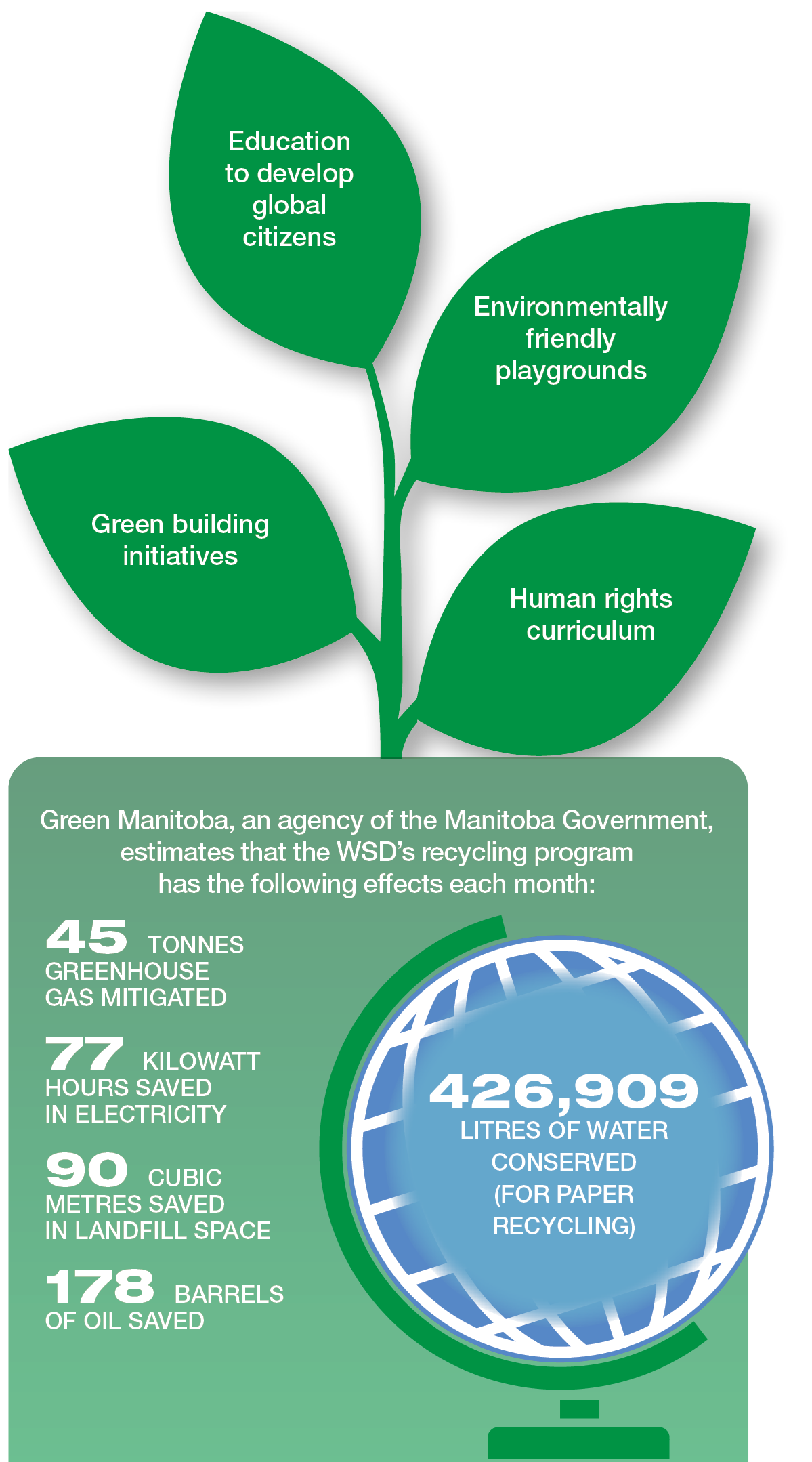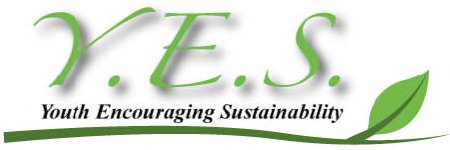Five Domains of Education for Sustainable Development
November 10, 2023
As part of our Education for Sustainable Development Plan, the WSD has identified five key areas to guide the implementation of ESD in our division.

Governance
The WSD has structures in place to support the following governing areas in the implementation of ESD:
- Decision Making. The Winnipeg School Division ESD Committee has a broad base of district members, department members, administrators, consultants, and teachers to oversee the planning, monitoring, and reporting of sustainable development on an annual basis.
- Financing and Budget. The WSD uses progressive approaches to financial modelling and budgets to access grants/funds for projects/partnerships with various organizations and businesses. These approaches reflect both short and long term sustainability of the education system.
- Monitoring and Evaluation. The WSD uses mechanisms, like the Eco-Globe checklist, to measure the progress of ESD implementations.
Curriculum, Teaching, Learning
The WSD touches on the key elements of education to give students the opportunity to explore and practice ESD as a concept.
- Curriculum. Students learn, develop, and practice an understanding of sustainable development through the integration of subjects across grade levels.
- Teaching. Teachers use inquiry, active learning, and problem-solving techniques to address local and global perspectives. All school staff use ESD resources to support and encourage ESD-oriented projects.
ESD resources are available for:- Staff development;
- Pedagogy to develop critical thinking;
- Active citizenship;
- Futuristic thinking;
- Inquiry and active learning; and
- Problem-solving in a local and global context.
- Learning. Both teachers and students participate in learning opportunities to develop an understanding of the social, environmental, and economical issues regarding sustainability and their interdependence. In addition, school staff create outdoor classrooms and environments for students to learn about sustainable practices.
Capacity Building

The WSD’s Education for Sustainable Development Plan addresses the following key staff to build a capacity for practicing ESD:
Teachers build capacity through Professional Development (PD). PD provides teachers with ESD competencies in the five domains:
- Knowledge;
- Systems thinking;
- Emotions;
- Ethics and values; and
- Actions.
Non-teaching staff build capacity through training to provide them with the knowledge and skills required to further the Division’s goals in sustainable development and ESD.
Senior and School Administration build capacity through demonstrating leadership in implementing ESD.
Facilities and Operations
The WSD continually strives to apply sustainability principles to all aspects of its operations including the design, construction, maintenance and renewal of its facility infrastructure. The following is a sampling of the WSD’s facility and operational sustainable development initiatives.

Energy and Water Reduction
In early 2000, the WSD embarked on a new strategy which utilized an energy performance based contract model as the basis for improving the learning environment for students and reducing the WSD’s carbon footprint. Over a 10 year period, the WSD engaged the services of energy service companies to undertake a variety of facility modifications under the premise that the cost of the facility modifications would be fully recovered through reductions to the WSD’s utility costs. By the end of 2015, 60 facilities will have received a variety of energy and water reduction modifications under this energy performance contract model.
Since 2008, the WSD, with funding assistance from the Province of Manitoba and grants provided under Manitoba Hydro’s PowerSmart program has been upgrading its heating plants, roof and window assemblies to provide systems which will further reduce energy consumption and provide improved comfort for our students and staff.
Status of Facilities and Operations Improvement Measures
New Construction and Maintenance
With the funding support and guidance provided by Province of Manitoba, all major additions to our schools are being designed to achieve a LEED (Leadership in Energy and Environmental design) Certified or Silver rating. The WSD is also striving to ensure that construction and maintenance materials utilized in the renovation and maintenance of facilities follow LEED resource re-use, recycled content, low VOC and durability criteria.
Recycling
The WSD has a division-wide program to recycle paper and cardboard in all of its schools and departments. Each month on average 21,837 kilograms of recyclable materials—the equivalent weight of two fully loaded 66-passenger school buses-heads off to be recycled.
Green Manitoba, an agency of the Manitoba Government, estimates that the WSD’s recycling program would have the following effects each month: 45 tonnes greenhouse gas mitigated; 77 kilowatt hours saved in electricity; 426,909 litres of water conserved (for paper recycling); 118 cubic yards saved in landfill space and 178 barrels of oil saved.
Community Beautification
Each year students and school staff participate in division-wide projects to clean/beautify their communities. This school year, over 19,000 students and staff members participated in community beautification projects.
Transportation
The Winnipeg School Division was the first division in Manitoba to use biodiesel in all 90 of its school buses. The WSD’s fleet of buses also operates on an idle-free basis to reduce emissions at stops.
In June 2010 routing and scheduling software was purchased to help make routes more efficient and reduce the number kilometers travelled throughout the school year.
The WSD is researching other measures to reduce fuel consumption and emissions including the purchasing of buses powered using propane, GPS equipment to help create further efficiencies in routing and monitor school operation to ensure they are being operated in a manner that reduces fuel consumption.
Custodial and Cleaning Operations
The WSD’s purchasing practices always consider sustainability principles in its decisions regarding custodial cleaning operations. Some examples include: ensuring the product is ergonomically friendly; requires less resources such as water or power; emits less noise; has good dust collection or filtration and is made of material that has a recycled content.
The WSD has found many ways to go “greener.” Concentrates are used in an effort to reduce waste. All wooden floor sealer/varnish is now an environmentally-friendly water-based product, replacing the former oil-based product. Zinc-free floor finishes and floor strippers are being used. Staff are also investigating and testing hand towel paper products and dispensers that are “green” certified.
Custodial staff started are also using micro-fibre technology for cleaning. This product has significant impact in the amount of chemicals required for cleaning sinks, counters, desks, telephones, drinking fountains and glass. The cloths also significantly reduce the amount of airborne dust created when cleaning dusty surfaces. The cloths stand up to being laundered many times and have been found to last a year or longer.
Partnerships
The WSD has partnerships in place to support the continued implementation of ESD and sustainable development. These partnerships provide opportunities for parents and the community to practice ESD principles and address local sustainability issues through community projects.
WSD provides students with opportunities to explore and develop partnerships with other schools and organizations both inside and outside the division.

Youth Encouraging Sustainability
Y.E.S. invites you to join us for a day of inspiration, learning, networking, and celebrating Manitoba students who are creating their own sustainable futures in their classrooms and beyond.
